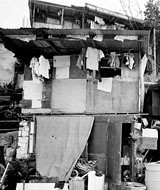Intersections with Informality

Going on right now at the Walter Phillips Gallery at the Banff Centre in Alberta, Canada is an exhibition called Informal Architectures which looks pretty interesting and would no doubt get my attention if I were there. All of which I think is part of a bigger ongoing project that had a symposium at the Tate Modern in February earlier this year, and will continue next year with another part at PLUG IN ICA.

Implying perhaps spaces of an informal economy or a counter-landscape to that of the strictly formal, the show is about how certain political and social assumptions are embedded into the landscape, be it subconscious determinants emanating from fear, or consumerism, political residue, cultural collectives of identity which continue to push through the landscape in reverse gravities of informality and subversions of common-place power, presumed knowledge, inherent self-contradictions -- the exhibition looks to explore the emergence of "incessant counter-narratives haunting modernity’s ideological projections" and ultimately how a larger sense of failure has been institutionalized by the incorporation of assumption into the design of our built environment.
Right up Subtope's alley, to say the least. Actually, I am just going to post the entire statement of the show as written by Anthony Kiendl, the exhibition's curator, right here (for you and my own future reference, since I am curious to toy with these notions myself as time goes on):
Informal Architectures is an exhibition gathering the work of a number of artists exploring the intersections of architecture, social thought and failure. The exhibition presents predominantly new works (some commissioned and produced by artists at The Banff Centre) with select historical works. When viewed together, these works form a narrative about the often unspoken role of architecture in controlling people.
This exhibition describes a contemporary landscape of social, political and cultural assumptions. These ideas are incorporated into the structures of the built environment —economic, physical, and institutional—affecting the recent past, uncertain present and near future. In this landscape, technology and consumerism are the primary vehicles of a utopian modernity. But waste, materialism, entropy and abjection form incessant counter-narratives haunting modernity’s ideological projections. In and around these scenes of our post-9/11 environment, artists re-configure our surroundings.
While monumentality continues to weigh on contemporary art and architectural practices in western societies, alternative strategies in spatial culture have proliferated since the 1960s. By considering work by artists from diverse and unconventional perspectives, the assumptions and dream-narratives of modern art and architecture may be re-imagined. The artists in Informal Architectures visualize economies of both excess and lack —chocolate and dirt, shopping malls and ruins, humour and destruction—proposing alternative strategies and criteria for the creation, representation and inhabitation of space—or of how to be in the world.
Reviews of some of the featured artists can be read right here, including "Luanne Martineau’s work Parasite Buttress, a flesh-like form that can double as a mattress, descends from the gallery wall and unfurls across the floor." Or, William Pope.L, who has installed a "Historic Building, a temporary structure that oozes 100 gallons of chocolate syrup." There's newly commissioned works by Jimmie Durham, Eleanor Bond, Edgar Arceneaux, Matthew Sloly, Vincent Galen Johnson, and Olga Koumoundouros. There's a film of Gordon Matta-Clark's, the homeless shelter installation by Japanese architect Kyohei Sakaguchi, and the list goes on.

Needless to say, check it out if you can and, if you feel so inclined, drop me a line to let me know what you thought. Maybe one day I will find a way to get lucky and get paid to go cover this type of thing, but until then - I will just have to sit here and advertise it. So go!







0 Comments:
Post a Comment
<< Home